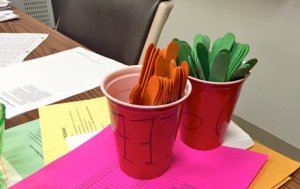3 Practices to Promote Equity in the Classroom
To engage all students equitably in classroom activities, track their participation and restructure discussions so that everyone gets a turn.
I recently observed a classroom where students were presenting history projects to rows of silent and obedient classmates. Though the projects were diligently constructed, I couldn't focus on their content because I was distracted by two facts: only the teacher was asking questions, and he kept calling exclusively on girls to present.
Ten minutes later, I walked into a completely different classroom where students rotated through the room presenting group projects to each other. The teacher instructed his class to "work to understand" the content through discussion, and every voice filled the room.
These two experiences resurfaced a long-held question: What makes for an equitable classroom? While this topic deserves a whole book, here are three simple practices that you can try on to increase the range and frequency of student voices in your classroom.
Practice 1: Use Equity Sticks
Equity sticks are a cheap and powerful way to check your biases at the door. Simply buy a box of popsicle sticks (or index cards, or bookmarks, or anything compact, really), use a Sharpie to write one student's name per stick, and toss them all into a cup or jar next to a second, empty cup for the "used" sticks. Each time you facilitate a class discussion, pull out an equity stick at random and ask that student to share. Once they have participated, toss their stick in the other cup, and keep on doing this until you've cycled through the class.

Equity sticks keep students on their toes, mentally alert, and poised to contribute. When used routinely, this practice promotes a culture of participation and attention. For an app that serves the same purpose, check out Stick Pick.
Practice 2: Track Participation Data
It's also really powerful to gather data on student participation. To do this, create a simple "equity tracker" with students' names on the left side and a column for each day of the week. Carry it around religiously on a clipboard, and each time you call on a student or someone volunteers to speak, jot down a tally mark. At the end of the week, add up your marks and analyze the data:
- Who is participating the most?
- Who is participating the least?
- What patterns of participation do I see with respect to race, gender, language of origin, learning ability, location in the room, etc.?
Use this data to set a small participation goal for the following week. For example: "Next week, I aim to invite the students with special needs in my classroom to share at least once per day."
Practice 3: Experiment With Discussion Structures
Finally, the best way to promote student voice is to maximize and vary your structures for discussion. Well-designed discussions shift the talk ratio and the cognitive load from you to your students. There are countless ways to structure student talk, but here are a few tried and true methods.
Think-Pair-Share: Each student silently thinks (and maybe also reads and/or writes) about a prompt, text, or question. Students then pair up and share their ideas.
Quote Mixer: Each student is given a different quote or other form of text (this could be an image or graph, for example). Students move around the room, pair up, share their text and response to it, switch cards, find a new partner, and repeat for 1-2 additional rounds.
Talking Pennies: In groups of three to five, students are given a question or set of questions to discuss. Each student receives an equal number of pennies. Each time someone participates, they must first put one of their pennies into the middle of the table. A student who has used up his or her pennies must wait for all the other students' pennies to be in the middle before speaking again.
Creating an equitable classroom can feel daunting, but I find it helpful to think of small changes that can make a big difference in increasing student voice.
